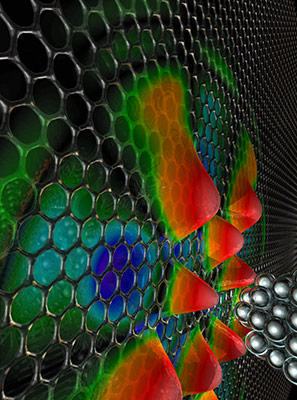
An international research group led by scientists at NIST has developed a technique for creating nanoscale whispering galleries for electrons in graphene. The researchers used the voltage from a scanning tunneling microscope (right) to push graphene electrons out of a nanoscale area to create the whispering gallery (represented by the protuberances on the left), which is like a circular wall of mirrors to the electron.
GAITHERSBURG, MD--An international research group led by scientists at the U.S. Commerce Department's National Institute of Standards and Technology (NIST) has developed a technique for creating nanoscale whispering galleries for electrons in graphene. The development opens the way to building devices that focus and amplify electrons just as lenses focus light and resonators (like the body of a guitar) amplify sound.
They reported their findings in the May 8, 2015, issue of Science.
In some structures, such as the dome in St. Paul's Cathedral in London, a person standing near a curved wall can hear the faintest sound made along any other part of that wall. This phenomenon, called a whispering gallery, occurs because sound waves will travel along a curved surface much farther than they will along a flat one. Using this same principle, scientists have built whispering galleries for light waves as well, and whispering galleries are found in applications ranging from sensing, spectroscopy and communications to the generation of laser frequency combs.
"The cool thing is that we made a nanometer scale electronic analogue of a classical wave effect," said NIST researcher Joe Stroscio. "These whispering galleries are unlike anything you see in any other electron based system, and that's really exciting."
Ever since graphene, a single layer of carbon atoms arranged in a honeycomb lattice, was first created in 2004, the material has impressed researchers with its strength, ability to conduct electricity and heat and many interesting optical, magnetic and chemical properties.
However, early studies of the behavior of electrons in graphene were hampered by defects in the material. As the manufacture of clean and near-perfect graphene becomes more routine, scientists are beginning to uncover its full potential.
When moving electrons encounter a potential barrier in conventional semiconductors, it takes an increase in energy for the electron to continue flowing. As a result, they are often reflected, just as one would expect from a ball-like particle.
However, because electrons can sometimes behave like a wave, there is a calculable chance that they will ignore the barrier altogether, a phenomenon called tunneling. Due to the light-like properties of graphene electrons, they can pass through unimpeded—no matter how high the barrier—if they hit the barrier head on. This tendency to tunnel makes it hard to steer electrons in graphene.
Enter the graphene electron whispering gallery.
To create a whispering gallery in graphene, the team first enriched the graphene with electrons from a conductive plate mounted below it. With the graphene now crackling with electrons, the research team used the voltage from a scanning tunneling microscope (STM) to push some of them out of a nanoscale-sized area. This created the whispering gallery, which is like a circular wall of mirrors to the electron.
"An electron that hits the step head-on can tunnel straight through it," said NIST researcher Nikolai Zhitenev. "But if electrons hit it at an angle, their waves can be reflected and travel along the sides of the curved walls of the barrier until they began to interfere with one another, creating a nanoscale electronic whispering gallery mode."
The team can control the size and strength, i.e., the leakiness, of the electronic whispering gallery by varying the STM tip's voltage. The probe not only creates whispering gallery modes, but can detect them as well.
NIST researcher Yue Zhao fabricated the high mobility device and performed the measurements with her colleagues Fabian Natterer and Jon Wyrick. A team of theoretical physicists from the Massachusetts Institute of Technology developed the theory describing whispering gallery modes in graphene.
Graphene-based quantum electronic resonators and lenses have as yet untold potential, but if conventional optics is any guide, the ramifications could be huge.
Fabrication and measurement of the device was performed at NIST's Center for Nanoscale Science and Technology (CNST), a national user facility available to researchers from industry, academia and government.
A non-regulatory agency of the Commerce Department, NIST promotes U.S. innovation and industrial competitiveness by advancing measurement science, standards and technology in ways that enhance economic security and improve our quality of life. To learn more about NIST, visit www.nist.gov.
Y. Zhao, J. Wyrick, F. Natterer, J. Rodriguez-Nieva, C. Lewandowski, K. Watanabe, T. Taniguchi, L. Levitov, N. Zhitenev, and J. Stroscio. Creating and probing electron whispering-gallery modes in graphene. Science. 8 May 2015: Vol. 348, no. 6235, pp. 672-675. DOI: 10.1126/science.aaa7469.

